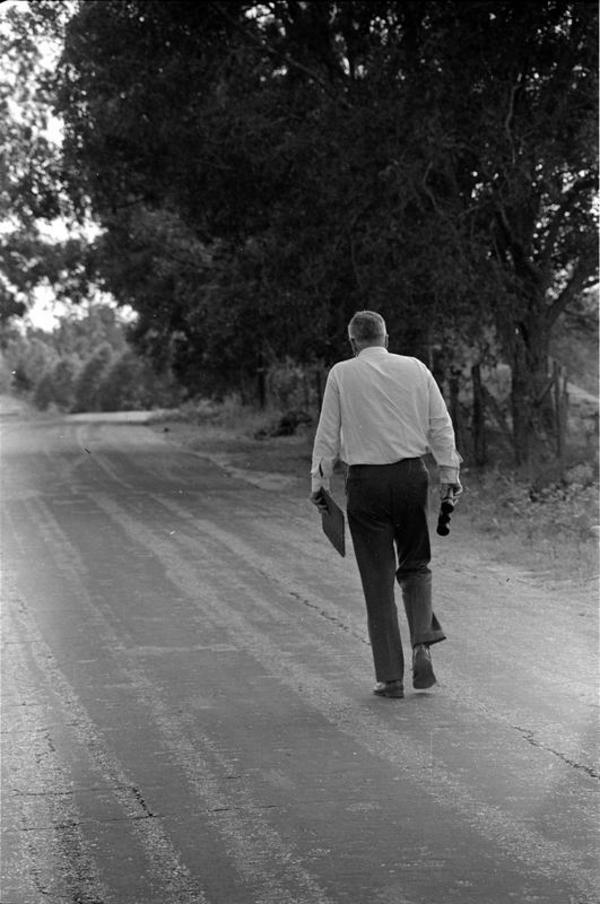item: 193
Tatum Salt Dome Blast
Item # 180-269
The photograph was identified by Moncrief as "Salt Dome Blast, 1964." Newspaper articles in the Hattiesburg American indicate that Moncrief was one of the many members of the press who covered this event.
On October 22, 1964, a five-kiloton nuclear device was detonated 2,700 feet below the surface of the earth in the Tatum salt dome, Lamar County. The blast was conducted by the U.S. Atomic Energy Commission (AEC) and U.S. Department of Defense (DOD) as part of Project Salmon. The test was part of the VELA Uniform program, which had been initiated by 1959 recommendations to increase research in seismology. Specifically, they were investigating "decoupling theory" and the ability to detect or hide underground nuclear detonations in cavities. Such research was significant in determining whether the Soviet Union was conducting secret nuclear tests.5
The majority of tests were conducted at the AEC's Nevada site, but the Tatum salt dome near Baxterville, Lamar County, and Bruinsburg dome near Port Gibson, Claiborne County, were identified as suitable mediums for testing. In February 1961, AEC leased a 1,400-acre area from the Tatum Lumber and Pecan Company, and site preparation and cavity drilling began. The Salmon test, identified in local news reports as part of Project Dribble, was originally scheduled for September 1963 but was delayed due to bad weather. At ground zero the nuclear charge was located "in solid rock salt beneath a 600 foot concrete plug and 2100 feet of gravel." The official command post was located approximately 2½ miles southwest of ground zero. In addition to seismographs at the command post, equipment was also placed locally near Wiggins, Tylertown, Purvis, Prentiss, Beaumont, and Ellisville, Mississippi, and in Bogalusa, Louisiana. News reports indicate that the countdown began at 9:44 a.m., as it had done on two previous occasions, but this time the crowd of over 50 "newsmen, politicians and observers mounted on the crest of the hill to watch the shot" were not disappointed as the blast exploded precisely at 10:00 a.m. Reporters at the scene described how the "earth rolled and bumped three or four times shaking a communications trailer and other structures and bobbing 50 cars and trucks on their springs." Project employee Billy Ray Anderson recalled how the observation trailer rocked and rolled and "[t]hose politicians came running out of the trailer, grabbing their handkerchiefs and wiping sweat off their foreheads."6
AEC officials were pleased with the results and stressed that the odds were "better than 100 to one against any detectable quantity of radiations above the plugged hole." They reported "there was no indication of anything occurring except what was expected." At the command post some equipment was dislodged and communications and subterranean listening devices were "knocked out." Residents within a mile and a half of the blast site had been asked to leave their homes during the test and were paid a nominal sum for the inconvenience. They were allowed back after 1:00 p.m. that day. Prior to the blast, the chimneys, porches, and out-buildings of some local homes were braced. Immediately after the blast, reports of damage began to filter in, and by October 26 AEC had received 205 complaints about structural damage. Most of these were minor, but the papers reported that the home of at least one family was rendered uninhabitable. In addition to cracks in homes and road paving, Billy Ray Anderson, who drove a water truck during the project, remembered having to deliver water to local residents whose wells were soured and turned black with silt.7
After Salmon, a second nuclear test, Project Sterling, was held at Tatum on December 3, 1966. Two non-nuclear tests were detonated on February 2, 1969, and April 9, 1970, as part of the Miracle Play program. No further testing took place at the site. In 1971, AEC began decommissioning the site, which included dismantling equipment and mobile facilities and cleaning up a contaminated waste pit. Upon completion in 1972, the U.S. Department of Energy (DOE) established a long-term hydrological monitoring program. A commemorative stone marker was also erected on the spot where the nuclear devices were lowered into the ground. Since its closure, anxiety about radioactive contamination in the area has risen. In 1979, after University of Mississippi chemists discovered contaminated amphibians, Governor Cliff Finch closed the area to the public and evacuated residents. The scare subsided when the scientists retracted their findings due to the realization that the results had been caused by contaminated equipment. Elevated tritium (a radioactive isotope) levels were discovered in the 1990s, and the DOE expanded its work at the site with a program of Remedial Investigation and Feasibility studies, headed by the DOE Nevada field office. In addition, state health department and DOE studies of the rates of reported cancer-related deaths in the locality in the 1980s did not find elevated cancer rates among those living close to the test site. Regular State Department of Health, DOE, and Environmental Protection Agency (EPA) tests continue to show no evidence of off-site contamination or public safety concerns. However, these findings do little to quell the fears of some residents, who see a link between cancer deaths in the area and the nuclear tests. Today the site is a wilderness that was purchased by the government in 1992 and remains fenced off from the public.8
5 United States Atomic Energy Commission, Project Sterling, (Hattiesburg, Miss. [s.n.]), 1966, 5-6.; Dixie, May 14, 1967.
6 Hattiesburg American, October 22, 1964; James W. Crawley, "The Day We Nuked Mississippi," July 11, 2005, Washington Dateline, Richmond Times-Dispatch, August 4, 2005, <http://washdateline.mgnetwork.com/index.cfm?SiteID=wsh&PackageID=46&fuseaction=article.main&ArticleID=7294&GroupID=215> (August 4, 2005).
7 Memphis Commercial Appeal, March 3, 1961; Hattiesburg American, September 29, 1964; October 20-26, 1964; Crawley, "The Day We Nuked Mississippi."
8 Clarion Ledger, May 26-27, 1979; Crawley, "The Day We Nuked Mississippi"; U.S. Department of Energy, Office of Environmental Management, "Salmon Site" 1999 <http://web.em.doe.gov/bemr96/sats.html> (August 4, 2005); Bonnie S. Richter, Heather G. Stockwell, Office of Epidemiologic Studies U.S. Department of Energy, "Descriptive Study of deaths from Cancer associated with residential proximity to the site of underground nuclear detonations," 1998, Archives of Environmental Health, March-April 1998, <http://www.findarticles.com/p/articles/mi_m0907/is_n2_v53/ai_20596011#continue> (August 4, 2005); Department of the Environment, "News for Immediate Release," August 7, 1992, Tatum Salt Dome vertical file, MDAH.

return
